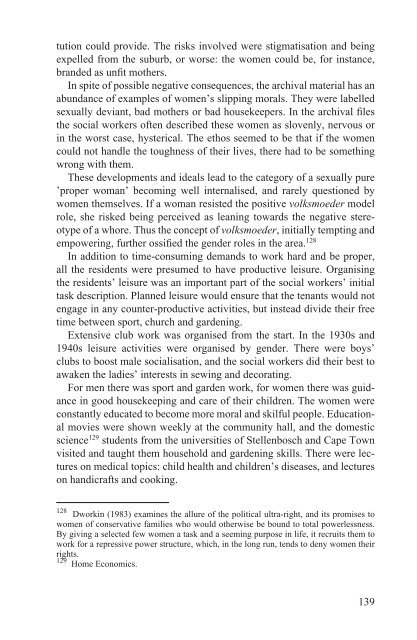The Making of a Good White - E-thesis - Helsinki.fi
The Making of a Good White - E-thesis - Helsinki.fi
The Making of a Good White - E-thesis - Helsinki.fi
Create successful ePaper yourself
Turn your PDF publications into a flip-book with our unique Google optimized e-Paper software.
tution could provide. <strong>The</strong> risks involved were stigmatisation and being<br />
expelled from the suburb, or worse: the women could be, for instance,<br />
branded as un<strong>fi</strong>t mothers.<br />
In spite <strong>of</strong> possible negative consequences, the archival material has an<br />
abundance <strong>of</strong> examples <strong>of</strong> women’s slipping morals. <strong>The</strong>y were labelled<br />
sexually deviant, bad mothers or bad housekeepers. In the archival <strong>fi</strong>les<br />
the social workers <strong>of</strong>ten described these women as slovenly, nervous or<br />
in the worst case, hysterical. <strong>The</strong> ethos seemed to be that if the women<br />
could not handle the toughness <strong>of</strong> their lives, there had to be something<br />
wrong with them.<br />
<strong>The</strong>se developments and ideals lead to the category <strong>of</strong> a sexually pure<br />
’proper woman’ becoming well internalised, and rarely questioned by<br />
women themselves. If a woman resisted the positive volksmoeder model<br />
role, she risked being perceived as leaning towards the negative stereotype<br />
<strong>of</strong> a whore. Thus the concept <strong>of</strong> volksmoeder, initially tempting and<br />
empowering, further ossi<strong>fi</strong>ed the gender roles in the area. 128<br />
In addition to time-consuming demands to work hard and be proper,<br />
all the residents were presumed to have productive leisure. Organising<br />
the residents’ leisure was an important part <strong>of</strong> the social workers’ initial<br />
task description. Planned leisure would ensure that the tenants would not<br />
engage in any counter-productive activities, but instead divide their free<br />
time between sport, church and gardening.<br />
Extensive club work was organised from the start. In the 1930s and<br />
1940s leisure activities were organised by gender. <strong>The</strong>re were boys’<br />
clubs to boost male socialisation, and the social workers did their best to<br />
awaken the ladies’ interests in sewing and decorating.<br />
For men there was sport and garden work, for women there was guidance<br />
in good housekeeping and care <strong>of</strong> their children. <strong>The</strong> women were<br />
constantly educated to become more moral and skilful people. Educational<br />
movies were shown weekly at the community hall, and the domestic<br />
science 129 students from the universities <strong>of</strong> Stellenbosch and Cape Town<br />
visited and taught them household and gardening skills. <strong>The</strong>re were lectures<br />
on medical topics: child health and children’s diseases, and lectures<br />
on handicrafts and cooking.<br />
128 Dworkin (1983) examines the allure <strong>of</strong> the political ultra-right, and its promises to<br />
women <strong>of</strong> conservative families who would otherwise be bound to total powerlessness.<br />
By giving a selected few women a task and a seeming purpose in life, it recruits them to<br />
work for a repressive power structure, which, in the long run, tends to deny women their<br />
rights.<br />
129 Home Economics.<br />
139
















